-
Posts
634 -
Joined
-
Last visited
Content Type
Forums
Profiles
Events
Store
Posts posted by Garrett
-
-
I'll start off by saying I'm not much of a revolver shooter. I've got a few of them and I enjoy playing with them, but they are primarily for plinking.
But I've heard / read the discussions where people talk about the virtues and dangers of loading .38 Special cases to .357 Mag pressures. If shot in a .357 revolver, they should certainly be capable of safely containing the pressures. The revolver competitors say the shorter cases eject sooner / easier. While those against the practice argue you could potentially get one into an "old, weak" .38 Special and blow it up.
I'm in the camp of those that load my own ammo, and my ammo goes in my guns. I'm good with that, and I'm comfortable shooting my ammo in my guns. Not so worried about my ammo getting into someone else's gun. And I think anyone that loads Major 9mm or .38 Super probably falls into the same camp.
Having said all of that, it is nice if there is some way to visually determine what load you are looking at. Yes - I label my ammo, and keep it separated. But a second verification is always a good thing. I do load some ammo for use with suppressors. I like how Hornady puts a second crimp groove on some of their heavier bullets. They just happen to be in the right place so you can load a "magnum" length cartridge using "special" cases.
I've been doing this for a while loading .44 Mag ammo in .44 Special cases with 300 gr. bullets.
I just loaded up some 180 grain .357s in .38 Special cases. They are loaded out to 1.600", just like a typical .357 Mag. I'm going for subsonic velocities, so I'm not trying to hotrod these in any case.
Thoughts? Suggestions?
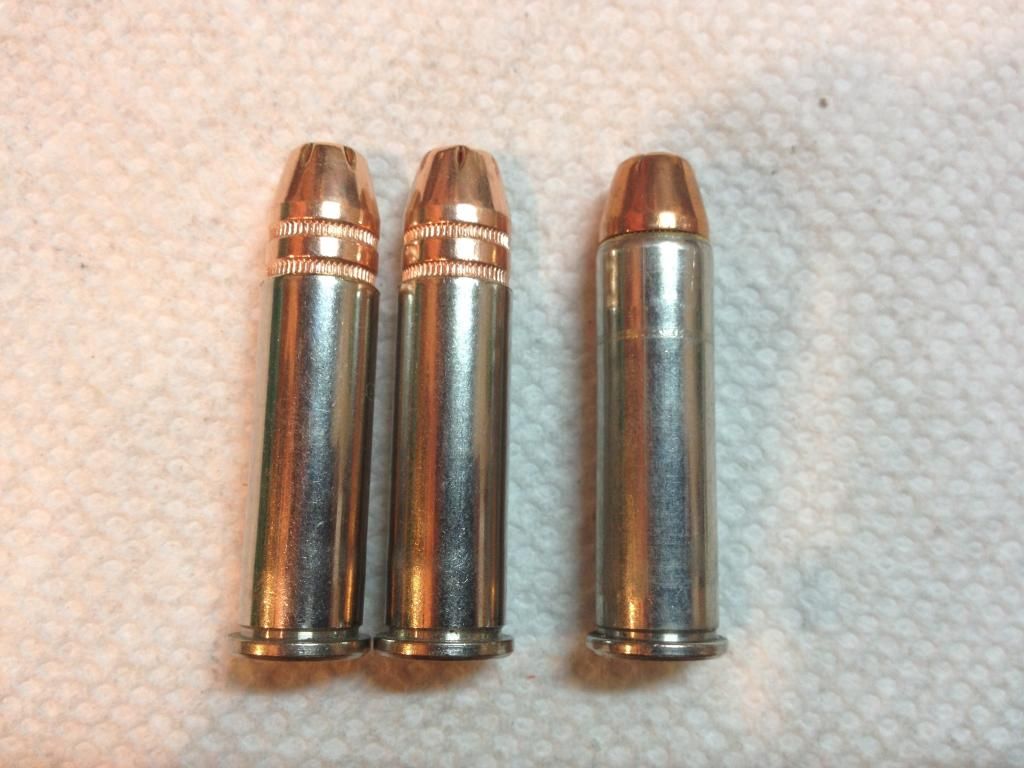
And for reference, I'm planning on running them through this:
-
I leave the powder in the hopper, with a masking tape label on the front to tell me what powder is in there. I haven't noticed much discoloration at all. For those who are getting a lot of discoloration, what is your reloading room like? Does your loading room have windows? Are you getting sunlight in there?
My loading room was converted from what was a large storage closet in the basement. There are no windows. The only light the room gets are when I am in there working.
It may be worth a try, for those in windowed rooms, to take a cardboard sleeve and cover the hopers when not actively loading with them.
-
I never paid attention to the bullet diameter (.355" vs. .356") before this. But I recently found it can make a noticeable difference, and that different guns will react differently to each. This was all with 9mm, and I haven't tried the XTreme at major PF in the .38 Super yet. But this seems relevant. I posted this a couple months ago at http://www.ar15.com/forums/t_6_42/419321_The_difference__001_can_make____or_fun_with_plated_bullets_.html
---------------------------------------------------------------------------------------------------------
I bought a few thousand XTreme 115 gr. 9mm plated bullets a few months back, as they had them on sale and not all weights / styles were available at most retailers. I typically load 147s to use with suppressors, and I like 124s for non-suppressed purposes. In fact, I don't think I've loaded 115s for several years now.The initial results were pretty unimpressive, accuracy-wise. I've been loading plated bullets since the late 90s without any issues. I've primarily used Berry's along with some Rainier. I have loaded XTreme bullets before with decent results, but those were 147 grain bullets. I realize you can easily over-crimp plated bullets, and it can cause issues. So I did an experiment. I've tried measuring at the case mouth to get an idea of how much crimp is applied, but between case thickness variations, and difficulty getting the very outside edge of the case, this can sometimes give unreliable results. So this time around, I crimped and pulled the bullets. That way, I could measure the actual crimp on the bullet its self.One set of bullets was crimped at .352" and the other at .354". I also loaded some Rainier 147 gr. bullets the same way, to see if there was any effect there. See below.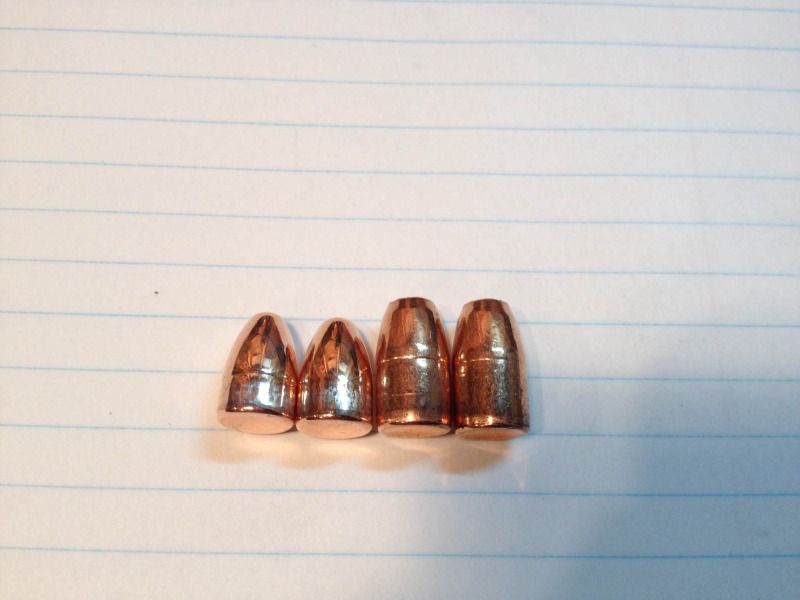 Unfortunately, I seemed to get poor results with either crimp set. The useful information I got was that I was not really getting any velocity increase by going to a heavier crimp, so there is no reason to crimp in that manner.I was questioning my loading practices, but I tried some jacketed bullets that I'd loaded previously and they produced a group half the size of the XTreme bullet loads. So were the bullets no good? I've shot their other bullets with good results.So I bought some Berry's 115 gr. bullets to test them against. One thing I noticed when measuring the two was that the Berry's bullet is .356" diameter, and the XTreme bullet is .355". Looking at their online listings, I see the XTreme 9mm bullets up through 135 gr. are .355", but the 147s are .356".So I load up a bunch of each, using Win 231, Win small pistol primers, and mixed range brass. I ended up bringing three guns and four barrels to the range today. I brought a Glock 17 with a factory barrel and a Lone Wolf barrel, a Glock 23 with a Lone Wolf 40-to-9mm conversion barrel, and an HK P9S. Of those, two barrels have cut rifling, and two have polygonal rifling.
Unfortunately, I seemed to get poor results with either crimp set. The useful information I got was that I was not really getting any velocity increase by going to a heavier crimp, so there is no reason to crimp in that manner.I was questioning my loading practices, but I tried some jacketed bullets that I'd loaded previously and they produced a group half the size of the XTreme bullet loads. So were the bullets no good? I've shot their other bullets with good results.So I bought some Berry's 115 gr. bullets to test them against. One thing I noticed when measuring the two was that the Berry's bullet is .356" diameter, and the XTreme bullet is .355". Looking at their online listings, I see the XTreme 9mm bullets up through 135 gr. are .355", but the 147s are .356".So I load up a bunch of each, using Win 231, Win small pistol primers, and mixed range brass. I ended up bringing three guns and four barrels to the range today. I brought a Glock 17 with a factory barrel and a Lone Wolf barrel, a Glock 23 with a Lone Wolf 40-to-9mm conversion barrel, and an HK P9S. Of those, two barrels have cut rifling, and two have polygonal rifling.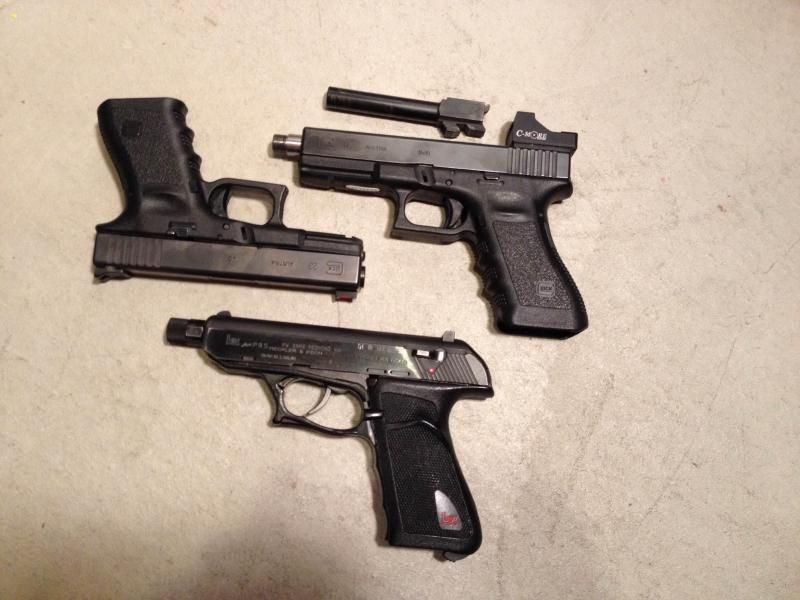 I shot 10-round groups from each, offhand at 10 yards. All shots went through the chronograph. Both loads through all barrels averaged between 1225 and 1250 fps. And without fail, the Berry's loads produced much tighter groups through the Glock barrels. In all instances, the [span style=font-weight: bold][span style=color: red]XTreme bullets are on the left, and Berry's are on the right.[/span][/span] See below.Glock 17 with factory barrel:
I shot 10-round groups from each, offhand at 10 yards. All shots went through the chronograph. Both loads through all barrels averaged between 1225 and 1250 fps. And without fail, the Berry's loads produced much tighter groups through the Glock barrels. In all instances, the [span style=font-weight: bold][span style=color: red]XTreme bullets are on the left, and Berry's are on the right.[/span][/span] See below.Glock 17 with factory barrel: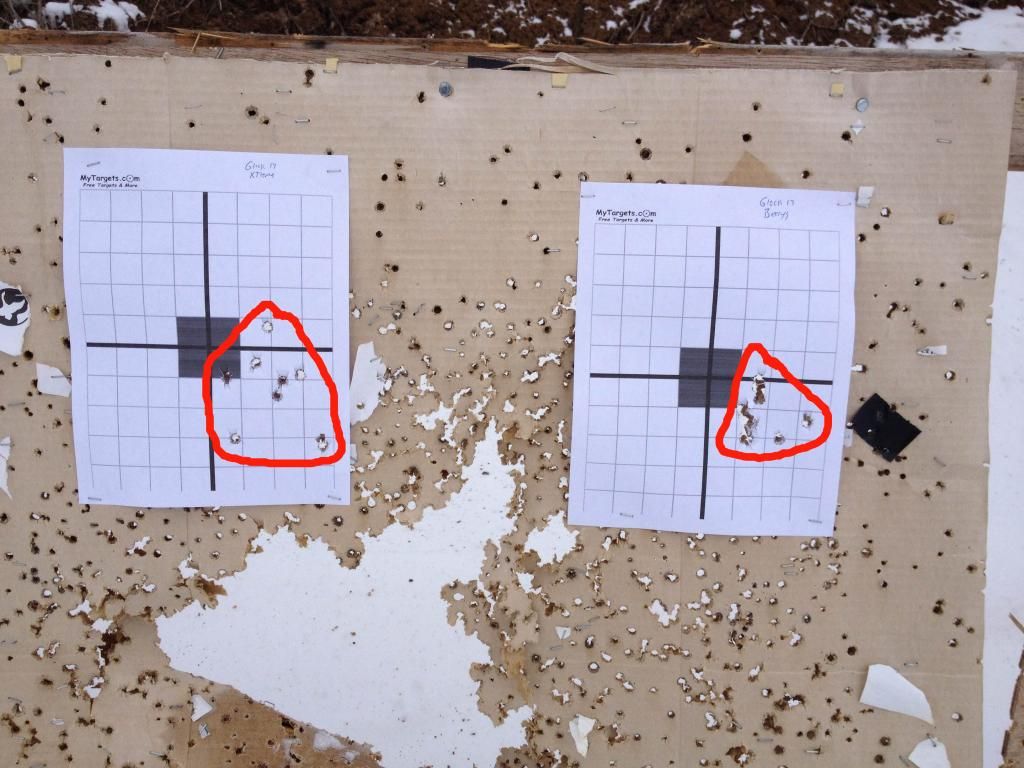 Glock 17 with Lone Wolf barrel:
Glock 17 with Lone Wolf barrel: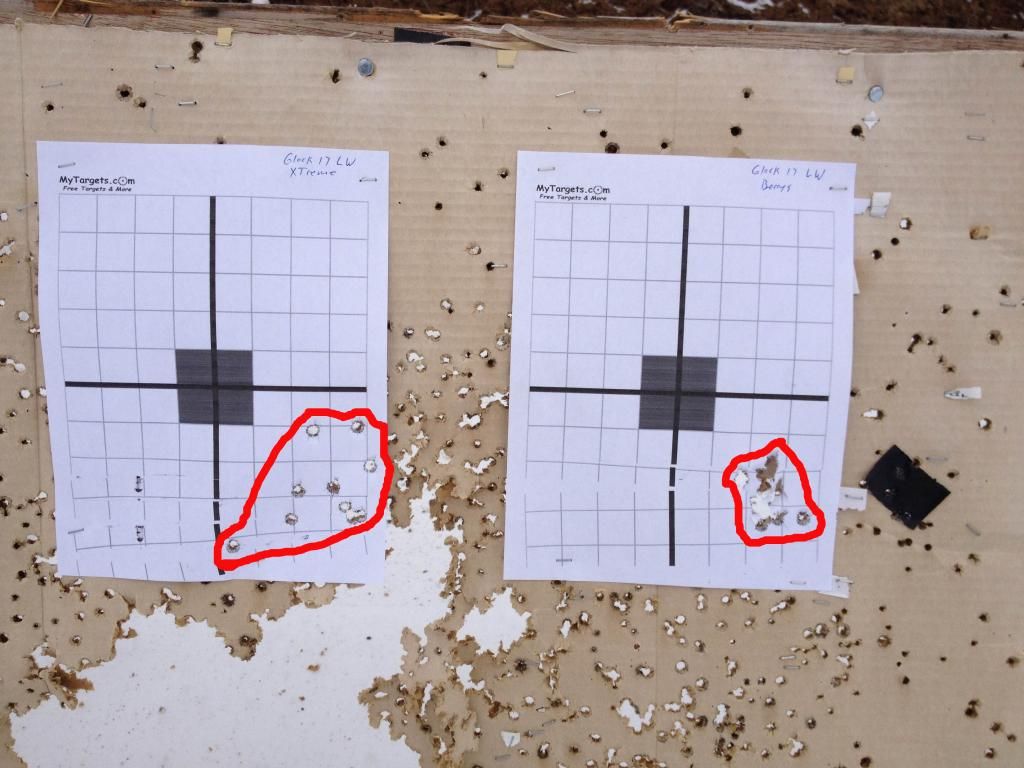 Glock 23 with Lone Wolf conversion barrel:
Glock 23 with Lone Wolf conversion barrel: One would start to think the bullets may be suspect. As it turns out, both the Glock factory barrel and the Lone Wolf barrels seem to prefer a .356" bullet. But find a gun that likes .355" bullets, and it's a different story. By far the best group of the day was from the XTreme bullets through the HK P9S.P9S
One would start to think the bullets may be suspect. As it turns out, both the Glock factory barrel and the Lone Wolf barrels seem to prefer a .356" bullet. But find a gun that likes .355" bullets, and it's a different story. By far the best group of the day was from the XTreme bullets through the HK P9S.P9S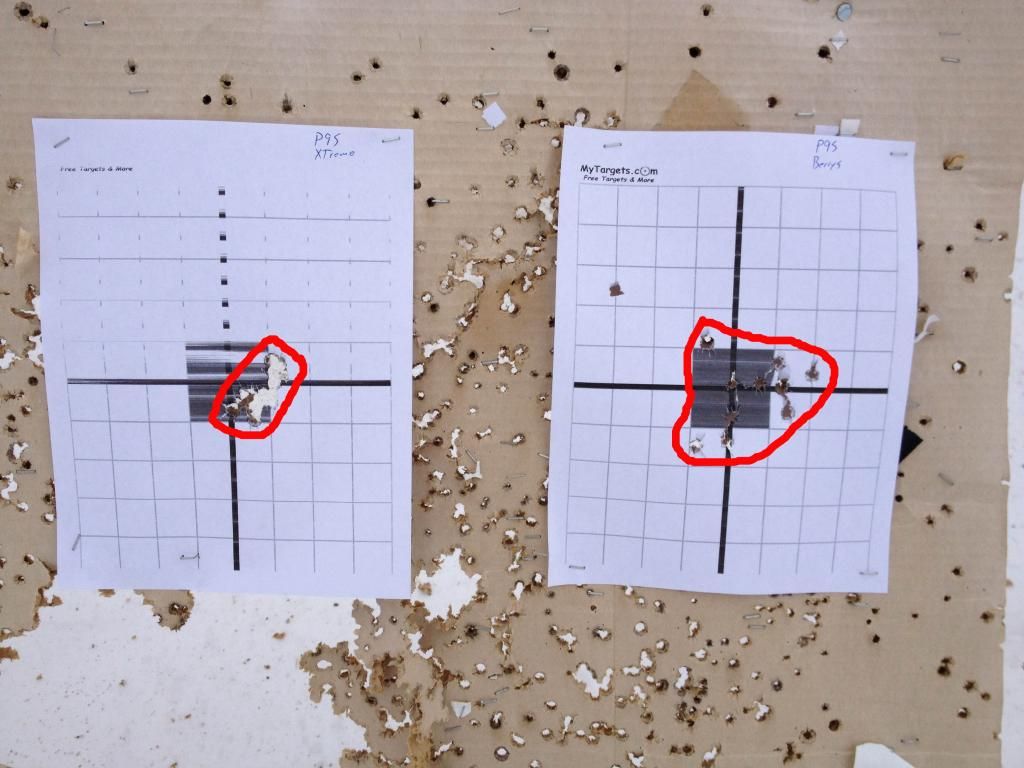 So, if you end up with a 9mm that won't group, try going up or down by .001". It may make all the difference in the world. I'm going to have to try this out with a few other guns, and see which gun prefers what size of bullet.
So, if you end up with a 9mm that won't group, try going up or down by .001". It may make all the difference in the world. I'm going to have to try this out with a few other guns, and see which gun prefers what size of bullet. -
He stated in post #5 that he intended to load them to the same OAL as a .357 Mag. With the right bullet / powder combo you could load shorter ammo to magnum levels safely as well (assuming you shoo them in a magnum-rated gun). You just have more opportunity to get the wrong ammo in the wrong gun.Garrett, it looks like you are using the same space for powder in each case which seems safe. When I read the OP my understanding was that he wanted to load at .357 velocity but using a smaller amount of case volume in the 38 special, because the shorter case reloaded faster.
FWIW, I understand the .357 case designed made longer, not so they could stuff more powder in there, but so you could not physically fit them in the chamber of a small-framed .38 Spl. Before that, people were shooting .38/200 loads (aka .38 HD, aka .38 Heavy Duty) in small- framed guns not intended for it, and causing damage to them.
-
If you pull a bullet and see a crimp ring you over crimped. It is that simple when it comes to service pistol. The results on accuracy with a plated bullet will be far more severe then jacketed. Just remove the flare. Nothing else. The sizing die creates the tension by sizing the case smaller then the bullet.
Yes. Something like the 2nd bullet on the left is what I ended up using for the subsequent testing.
-
I load .44 Mag in .44 Spl. cases. I do this specifically with 300 gr. bullets, so I can tell just by looking if the loaded round is 300 gr. (Spl case) or less (Mag case).
Hornady puts a second crimp groove on their heavy bullets (300 gr .44s and 180 gr .357s for example), in the correct location to load the cartridge to Mag OAL.
Your 140 gr Barnes bullets should be long enough to provide adequate neck tension, even if loading in a .38 Spl case. You may want to use a taper crimp die since there is no crimp groove on those bullets.
Set up correctly, I would not hesitate to load .357 Mag in .38 Spl cases. If you are concerned about case construction, you can cut cases in half and measure base thickness. Or you can just trim Mag cases to Spl length.
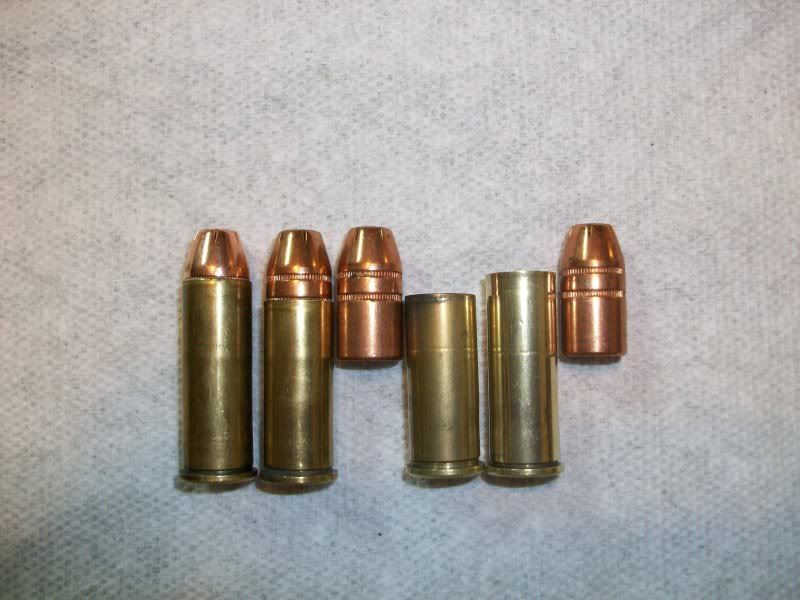
-
I recently posted this on another forum. This relates to 115 gr bullets, but still seems relevant. Bottom line is that you may need to test each diameter to see if your guns have a preference to a particular bullet diameter.
----------------------------
I bought a few thousand XTreme 115 gr. 9mm plated bullets a few months back, as they had them on sale and not all weights / styles were available at most retailers. I typically load 147s to use with suppressors, and I like 124s for non-suppressed purposes. In fact, I don't think I've loaded 115s for several years now.
The initial results were pretty unimpressive, accuracy-wise. I've been loading plated bullets since the late 90s without any issues. I've primarily used Berry's along with some Rainier. I have loaded XTreme bullets before with decent results, but those were 147 grain bullets. I realize you can easily over-crimp plated bullets, and it can cause issues. So I did an experiment. I've tried measuring at the case mouth to get an idea of how much crimp is applied, but between case thickness variations, and difficulty getting the very outside edge of the case, this can sometimes give unreliable results. So this time around, I crimped and pulled the bullets. That way, I could measure the actual crimp on the bullet its self.
One set of bullets was crimped at .352" and the other at .354". I also loaded some Rainier 147 gr. bullets the same way, to see if there was any effect there. See below.

Unfortunately, I seemed to get poor results with either crimp set. The useful information I got was that I was not really getting any velocity increase by going to a heavier crimp, so there is no reason to crimp in that manner.
I was questioning my loading practices, but I tried some jacketed bullets that I'd loaded previously and they produced a group half the size of the XTreme bullet loads. So were the bullets no good? I've shot their other bullets with good results.
So I bought some Berry's 115 gr. bullets to test them against. One thing I noticed when measuring the two was that the Berry's bullet is .356" diameter, and the XTreme bullet is .355". Looking at their online listings, I see the XTreme 9mm bullets up through 135 gr. are .355", but the 147s are .356".
So I load up a bunch of each, using Win 231, Win small pistol primers, and mixed range brass. I ended up bringing three guns and four barrels to the range today. I brought a Glock 17 with a factory barrel and a Lone Wolf barrel, a Glock 23 with a Lone Wolf 40-to-9mm conversion barrel, and an HK P9S. Of those, two barrels have cut rifling, and two have polygonal rifling.

I shot 10-round groups from each, offhand at 10 yards. All shots went through the chronograph. Both loads through all barrels averaged between 1225 and 1250 fps. And without fail, the Berry's loads produced much tighter groups through the Glock barrels. In all instances, the [span style=font-weight: bold][span style=color: red]XTreme bullets are on the left, and Berry's are on the right.[/span][/span] See below.
Glock 17 with factory barrel:

Glock 17 with Lone Wolf barrel:

Glock 23 with Lone Wolf conversion barrel:

One would start to think the bullets may be suspect. As it turns out, both the Glock factory barrel and the Lone Wolf barrels seem to prefer a .356" bullet. But find a gun that likes .355" bullets, and it's a different story. By far the best group of the day was from the XTreme bullets through the HK P9S.
P9S

So, if you end up with a 9mm that won't group, try going up or down by .001". It may make all the difference in the world. I'm going to have to try this out with a few other guns, and see which gun prefers what size of bullet.
-
What holster are you using? For IWB I suggest you try Crossbreed Holsters.
Hmmm. Good point. I've been using a gun with factory night sights for carry (which are pretty much dead, and ready to be changed out).
Prior to that I was using a gun with a "standard" IWB holster originally when the Heinie's would dig in. I switched to a Crossbreed a couple of years ago. The gun with the Heinies was apparently before that. I just checked, and the leather piece does indeed sit between the rear sight and my side.
I've got a spare set of sights (same Dawson F/O and Heinie rear) that I just put on the new gun, and it also appears to work well with the Crossbreed holster.
Problem solved - Thanks!
-
I've got a couple of Glocks with Dawson fiber optics up front and Heinie Slant Pros on the rear. They work well for shooting, but the Heinies tend to dig into one's side when used on a carry gun.
Any suggestions for what makes a decent rear sight that's less uncomfortable in a holster?
-
The P16-40 I bought 14 or 15 years ago runs fine with factory ammo. I had to use long-loaded ammo when I switched to an Ed Brown bull barrel. But I've since switched back to the factory barrel so I can run my ammo in any of my .40 caliber guns, and not have to have "Para only" ammo.
Pretty much all of my mags had to have the feed lips opened up, though.
-
-
The biggest determiner of accuracy of a G35 is how well you can control the hideously awful trigger as you pull it.
Yeah - this.
It's hard to beat even a so-so 1911/2011 trigger. I have a hard time getting over the mushy Glock trigger. The stock trigger is heavier, but less mushy. As you lighten up the trigger pull, the squishy feel increases as well.
I've played with some tuned triggers that felt pretty good. I'm pretty sure they had also disabled the internal safeties in the process. This wasn't much of a concern on a game gun, but still something to consider.
Just to do something different, I switched from the 2011 platform and played with some Glocks for a while. I found the USP a little better, and tried running that in a few matches, but locking up on the long reset bit me on some up close hoser targets. So I switched back to the Glock for a while. Much shorter reset, but trigger is still mush.
I think I'll switch back to a 2011 this spring.
-
As far as why I wouldn't use the Udie? I have the Udie in 9 and 40. I have seen enough 40 brass not gauge check even with my RCBS dies to recognize the value of the Udie in 40. I have not seen any reason to do this with the 9 cases... and I use lots of brass- including Blazer. The RCBS die does it's job and resizing it tighter with the UDie doesn't add any value to me... and it makes the press and my arm work much harder.
I reload a lot of brass that's been run through machine guns - some with relatively loose chambers. Switching to the U-die cut down significantly on the number of rounds that would not fit the gauge.
As for working the press harder, try using some lube. True - it's not needed with carbide dies. But it sizes so much smoother and easier. Any more, I fire a couple squirts of One Shot in the case feeder and I'm good to go.
-
They said that they did not provide data for this combination because the load would be compressed with any useable powder charge of W-231. Since it is a "ball" powder, they don't recommend any compressed loads with it.
Interesting. I've loaded and shot thousands of 147s with 231. If they are compressed, it can't be much if at all.
It shoots soft, runs clean, and is quiet with a suppressor. I generally use around 4 gr. of the powder. Seating depth depends on the bullet. RN are seated to around 1.135".
-
I have found AA powders more difficult to find. Many stores just don't carry it. IMR, Hodgdon, Win, and even Vhit all seem to be a lot more available locally. And this has been the case in 3 or 4 different locations.
-
Looks like I'd played with it briefly in '99. Records show I was making 129 PF with a 124 gr. Berrys at 4.3 gr powder, and got to 138 PF with 4.9 gr.
Nothing in my notes about flattened primers. These were all shot through a Taurus 92.
AA#2 is a really fine granular powder that runs pretty well through a powder measure. It's fast enough that it should shoot fairly soft.
-
When we went through this four years ago, I had some bullets on back order through Roze so long my credit card had expired. I think they called me about it 16 months after I'd placed the order. I had Lon since found something else to use.
-
Yep. Old is new again.
The upside down mounts were around before anyone came up with the sideways mounts.
-
Probably hotter than what you are looking for, but I've loaded as high as 4.2 gr. with a 147 gr. bullet. This is primarily used in a couple of subguns, but runs fine in pistols as well. Velocities I'm getting are:
M11/9 (5" barrel): 1008 fps.
Uzi (10.2" barrel): 1081 fps.
Glock 17 (Lone Wolf barrel): 1014 fps.
-
No good. I was going to launch them through a Desert Eagle. It generally needs a full-powered load with a slow powder to cycle.
I'll just load a few with H110 using data for a jacketed bullet and try them out.
I was mostly worried about the plating disbonding, or the bullet otherwise coming apart.
Thanks guys!
-
Thanks. I checked the Speer manual too, but the latest one I have is #12, which apparently came out before the 200 gr. .44 GD did. But yours didn't have any note not to go over a given velocity?
Does it list any data for that bullet in the .44 Mag section?
Thanks again!
-
I've got some 200 Gr. Gold Dots that are labeled specifically as ".44 Special" bullets. I'd like to play with them in some full-powered .44 Mag loadings, but I'm not sure why they would be labeled specifically for the .44 Spl. It has me wondering if there is a maximum recommended velocity for this particular bullet.
I can't find anything on Speer's website about it. Anyone have any idea?
-
Wow - I haven't really looked for Para mags for a while. They were always easy to come by - even during the mag ban. How times have changed (and this was posted prior to the current round of panic-buying.) Once upon a time, STI used to make mags specifically for the Para, as seen in the magwell of this relic of a race-gun.
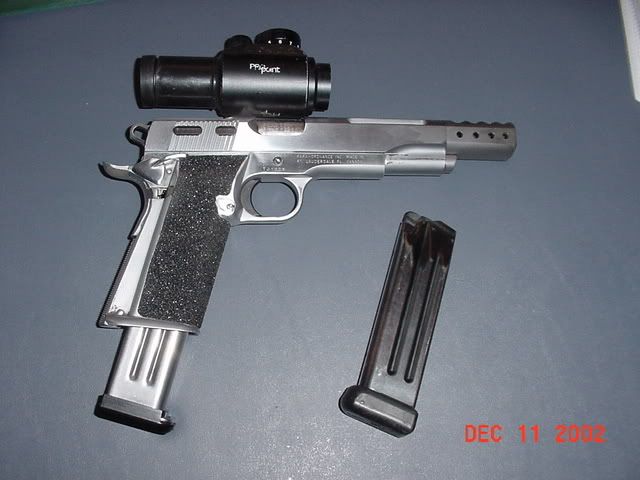
But the STI stopped making them quite some time ago, so they're going to be harder to find than Para mags. You can tell them, by the square notch at the rear of the mag, rather than the U-notch found on the standard STI mags.
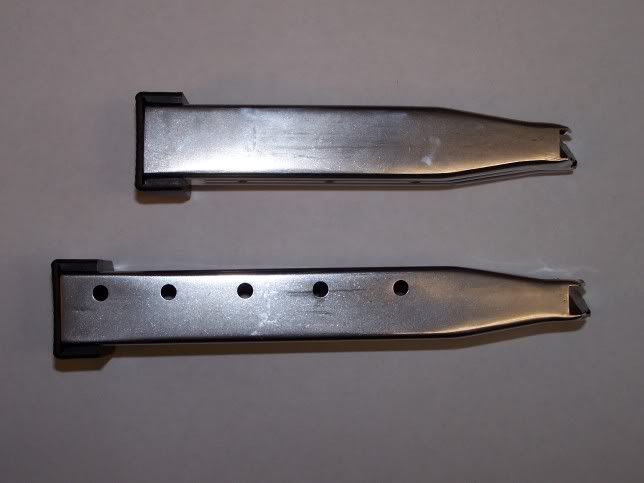
When the gun pictured above finally died, I converted them for an STI by modifying the notch in the mag bodies. To go the other way, you would either have to modify the catch in your gun, or weld up and re-cut the notch in the mag bodies. I thought at one time you could get a different mag catch for the Para that was cut for STI mags.
And as noted, some people have been able to get their STI mags to run in their Paras with no mods. I think I've got an STI .40 mag around here somewhere. I might have to try it out in the Para now just to see.
-
I find it interesting that a higher number of holsters do not cover the entire trigger guard area for the USP series. Here's an example - the Safariland Custom Fit series covers the trigger completely when the hammer is down (great for Production Division, for example). But when carrying cocked & locked, the trigger is slightly exposed. I think I've seen a couple of other USP holsters that have this same issue.




match video from a drone?
in Video Training Tips
Posted
You know how you get someone to video your run at a big match, and when you get a chance to review it, that darned RO keeps blocking the view? I've shot at one club that has a viewing platform above the shoot house. It makes for a great, unobstructed view.
So has anyone ever played with one of the video-mounted RC drones that are on the market now? These things have gotten down to a few hundred dollars in price, rather than the few thousand dollars they used to go for. For example, here's one fairly in-depth review:
This particular model can be bought new on Amazon for $300, or they have some used ones listed starting at $200. I imagine there are some other similar offerings out there as well. I don't have any first-hand experience with this unit other than watching a few reviews. But it seems to have some potential.
RC coptors of the past were fairly operator-skill intensive. This one seems to have enough onboard brain power to fly by its self without crashing every time you take your hands off the joystick (or I-pad in this instance). Seems if you wanted, you could just fly up above the range, get a decent view and set it in place to record. Or you could get a little more involved and follow the shooter around, but overhead for a better view.
Or with one of these, you could safely get some video from downrange, looking back toward the shooter. Might be a neat perspective.
Which brings up some important considerations. At what point does it become too much of a distraction to the shooter? If all they can hear is a whirring background noise from a drone hovering behind them, is that okay? What about if that noise changes as the drone follows the shooter around from 20 feet up, and to the rear? How distracting would it be, 40 yards downrange and above the shooting zone, but clearly visible to the shooter?
Good idea? Bad? Something worth pursuing?
Of course, this would not be some surprise you would just spring on any competitor at a match. The shooter would know in advance they would be getting videoed by an RC drone. You would probably want to run it by the match officials in advance as well.
Thoughts? Issues? Anyone try this before?